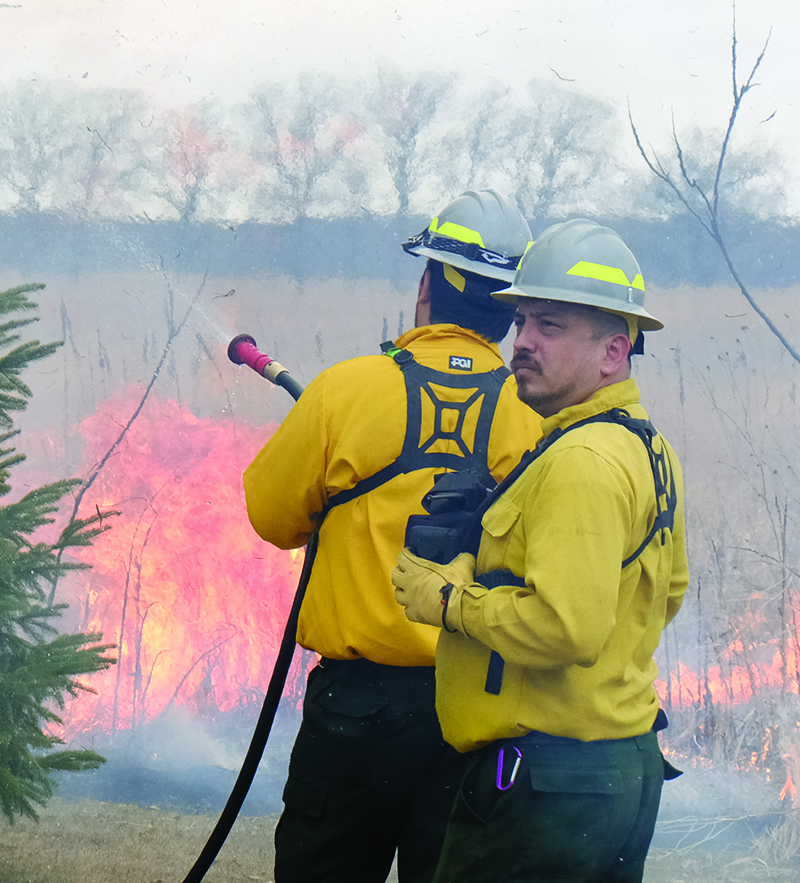
Eli Staples was helping DNR Commissioner Katie Draper at 11:40 on April 6 when he heard the radio chatter about a wildfire in District I. Jordan Williams had received the report of a wildfire near the Band’s wastewater treatment plant on Timber Trail Road, and from the weather that day and the information being exchanged, Eli knew it could get bad.
“The conditions that day were close to red flag,“ said Eli. “I knew what potential it had, so I called for backup on my way there.“
The state’s forestry office in Onamia sent five to the scene, and a DNR helicopter was also brought in.
Eli took charge as Incident Commander — a role he’s been trained for. “When I got there, it was 10 to 15 acres, but it grew quickly to 20-25 acres,“ said Eli.
“I gave them their assignments and told them to be safe, because it was going to move.“
The fire had started by the road — probably a cigarette butt or sparks from a vehicle — and spread through the dry grass and scattered trees up a large hill toward a tree line.
Beyond the trees was a grassy swamp, and past that, a residence.
With the crew’s efforts — and a little help — they stopped it before it reached the tree line.
“We were flanking it pretty good and got the head fire down,“ said Eli. “Then the winds switched and worked in our favor, so we were able to put guys in position to work in tandem to lay it down. By then it was already about 34 acres.“
Commissioner of Natural Resources Katie Draper, who oversees the forestry department and wildland crew, was proud of their efforts. “The Wildland Crew goes above and beyond working for the Band, not only during fire season, but 365 days of the year,“ she said. “Their hard work and dedication to our communities does not go unnoticed.“
“It was a good team effort,“ said Eli. “We couldn’t have done it without the entire crew.“
Trained and tested
Jacob Horbacz, the Band’s forester, oversees the wildland crew, which normally has five members in District I, three in District III, and two in District II.
During fire season, the Band’s crew headquarters in District I as the initial response team in the area, while the state covers initial response in District II and District III.
During the rest of the year, the wildland crew assists Jake with everything from forest inventory to land maintenance to trail work, logging, and snow plowing.
“We’re basically the muscle for the DNR,“ joked Eli.
The wildland crew is highly trained and certified. “The basic introduction is a pretty intense week-long course,“ said Eli. “That’s how you get certified as a wildland firefighter.“
Jake added, “We have to pass health exams every three years, and every year we have to pass a fitness exam.“ The exam includes a three-mile hike with a 45-pound vest. The hike needs to be completed in less than 45 minutes.
Some of the learning is on the job. Under the supervision of the Bureau of Indian Affairs, the crew helps with prescribed burns for wildfire mitigation and habitat restoration (as they did on April 20, where the fire photos on the cover and above were taken).
Eli said he owes a lot to former fire crew leader Dean Staples. “A lot of the knowledge I have came from Dean, and it allows me to know what to do when it comes to dealing with large fires at Mille Lacs,“ said Eli.

